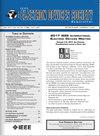A High-Performance and Low HCI Degradation LDMOS Device With a Hybrid Field Plate
IF 2
3区 工程技术
Q3 ENGINEERING, ELECTRICAL & ELECTRONIC
引用次数: 0
Abstract
In this paper, a high-performance and low-HCI (Hot carrier injection) degradation LDMOS (Lateral double diffused metal oxide semiconductor) device is introduced. It consists of an additional mini LOCOS (Local oxidation of silicon) field plate combined with a mini STI (Shallow trench isolation) field plate without an additional complex fabrication process. A series of devices have been fabricated, and the field plate corner profile is optimized. The proposed hybrid FP(Field plate) can effectively reduce the electric field peak, and the BV (Breakdown voltage) achieves as high as 78.9V while the采用混合场板的高性能、低 HCI 劣化 LDMOS 器件
本文介绍了一种高性能、低HCI(热载流子注入)降解 LDMOS(侧向双扩散金属氧化物半导体)器件。它由一个额外的微型 LOCOS(硅局部氧化)场板和一个微型 STI(浅沟道隔离)场板组成,无需额外的复杂制造工艺。我们制作了一系列器件,并优化了场板角轮廓。所提出的混合 FP(场板)能有效降低电场峰值,BV(击穿电压)高达 78.9V,而 ${R}_{on}{,}{sp}}$(特定导通电阻)低至 69.1~{{mathrm { m}}\Omega \cdot }{mm}^{2}$ ,与传统晶体管相比提高了 65.8%。同时,混合 FP 器件对 ${R}_{on,sp}$ 、阈值电压 ${V}_{T}$ 和栅-漏电容 ${C}_{GD}$ 的 HCI(热载流子注入)衰减性能更佳。在 ${I}_{d}$ 模式应力下,${R}_{on}{,}{sp}}$ 的劣化率仅为 8.6%,而传统器件的劣化率高达 15.8%。在导通状态下,${C}_{GD}$ 的劣化率仅为 9.1%,而传统器件的劣化率接近 59.9%。在高压应用区域,该器件的{C}_{GD}$劣化率几乎为 0%,而传统器件的劣化率高达 43.8%。这些结果表明,该器件在直流(DC)应用和射频(RF)应用中都具有很强的稳定性。
本文章由计算机程序翻译,如有差异,请以英文原文为准。
求助全文
约1分钟内获得全文
求助全文
来源期刊

IEEE Journal of the Electron Devices Society
Biochemistry, Genetics and Molecular Biology-Biotechnology
CiteScore
5.20
自引率
4.30%
发文量
124
审稿时长
9 weeks
期刊介绍:
The IEEE Journal of the Electron Devices Society (J-EDS) is an open-access, fully electronic scientific journal publishing papers ranging from fundamental to applied research that are scientifically rigorous and relevant to electron devices. The J-EDS publishes original and significant contributions relating to the theory, modelling, design, performance, and reliability of electron and ion integrated circuit devices and interconnects, involving insulators, metals, organic materials, micro-plasmas, semiconductors, quantum-effect structures, vacuum devices, and emerging materials with applications in bioelectronics, biomedical electronics, computation, communications, displays, microelectromechanics, imaging, micro-actuators, nanodevices, optoelectronics, photovoltaics, power IC''s, and micro-sensors. Tutorial and review papers on these subjects are, also, published. And, occasionally special issues with a collection of papers on particular areas in more depth and breadth are, also, published. J-EDS publishes all papers that are judged to be technically valid and original.
 求助内容:
求助内容: 应助结果提醒方式:
应助结果提醒方式:


